Pathology
blood analysis, dissection, and other applications of medical microscopy | |
| Specialist | Pathologist |
|---|---|
| Glossary | Glossary of medicine |
| Occupation | |
|---|---|
| Names |
|
Occupation type | Specialty |
Activity sectors | Medicine, Surgery |
| Description | |
Education required |
|
Fields of employment | Hospitals, Clinics |
Pathology is the study of
practicing pathology is called a pathologist.As a field of general inquiry and research, pathology addresses components of disease: cause, mechanisms of development (
Pathology is a significant field in modern medical diagnosis and medical research.
History
The study of pathology, including the detailed examination of the body, including dissection and inquiry into specific maladies, dates back to antiquity. Rudimentary understanding of many conditions was present in most early societies and is attested to in the records of the earliest
Modern pathology began to develop as a distinct field of inquiry during the 19th Century through
Modern medicine was particularly advanced by further developments of the microscope to analyze tissues, to which Rudolf Virchow gave a significant contribution, leading to a slew of research developments.
By the late 1920s to early 1930s pathology was deemed a medical specialty.
Etymology
The term pathology comes from the Ancient Greek roots of pathos (πάθος), meaning "experience" or "suffering" and -logia (-λογία), "study of". The Latin term is of early sixteenth-century origin and became increasingly popularized after the 1530s.[10]
General pathology
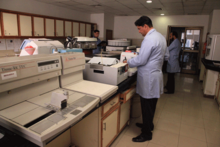
The modern practice of pathology is divided into a number of subdisciplines within the distinct but deeply interconnected aims of biological research and
Anatomical pathology
Anatomical pathology (Commonwealth) or anatomic pathology (United States) is a medical specialty that is concerned with the diagnosis of disease based on the
Cytopathology
Cytopathology (sometimes referred to as "cytology") is a branch of pathology that studies and diagnoses diseases on the cellular level. It is usually used to aid in the diagnosis of cancer, but also helps in the diagnosis of certain infectious diseases and other inflammatory conditions as well as thyroid lesions, diseases involving sterile body cavities (peritoneal, pleural, and cerebrospinal), and a wide range of other body sites. Cytopathology is generally used on samples of free cells or tissue fragments (in contrast to histopathology, which studies whole tissues) and cytopathologic tests are sometimes called smear tests because the samples may be smeared across a glass microscope slide for subsequent staining and microscopic examination. However, cytology samples may be prepared in other ways, including
Dermatopathology
Dermatopathology is a subspecialty of anatomic pathology that focuses on the skin and the rest of the
Forensic pathology
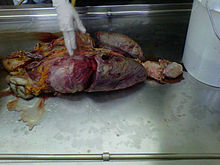
Forensic pathology focuses on determining the cause of death by
Histopathology
Histopathology refers to the microscopic examination of various forms of
Neuropathology
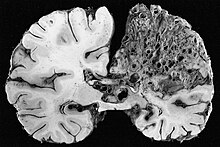
Neuropathology is the study of disease of nervous system tissue, usually in the form of either surgical biopsies or sometimes whole brains in the case of autopsy. Neuropathology is a subspecialty of anatomic pathology,
Pulmonary pathology
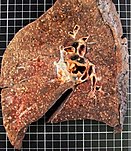
Pulmonary pathology is a subspecialty of anatomic (and especially surgical) pathology that deals with diagnosis and characterization of
Renal pathology
Renal pathology is a subspecialty of anatomic pathology that deals with the diagnosis and characterization of disease of the
Surgical pathology

Surgical pathology is one of the primary areas of practice for most anatomical pathologists. Surgical pathology involves the
There are two major types of specimens submitted for surgical pathology analysis: biopsies and surgical resections. A biopsy is a small piece of tissue removed primarily for surgical pathology analysis, most often in order to render a definitive diagnosis. Types of biopsies include core biopsies, which are obtained through the use of large-bore needles, sometimes under the guidance of radiological techniques such as
Clinical pathology
Clinical pathology is a medical specialty that is concerned with the diagnosis of disease based on the
Hematopathology
Hematopathology is the study of diseases of blood cells (including constituents such as
Molecular pathology
Molecular pathology is focused upon the study and diagnosis of disease through the examination of molecules within organs, tissues or
Oral and maxillofacial pathology

Oral and Maxillofacial Pathology is one of nine dental specialties recognized by the
Medical training and accreditation
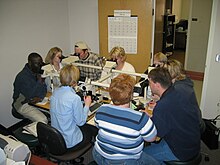
Becoming a pathologist generally requires
In the United Kingdom, pathologists are physicians licensed by the UK General Medical Council. The training to become a pathologist is under the oversight of the Royal College of Pathologists. After four to six years of undergraduate medical study, trainees proceed to a two-year foundation program. Full-time training in histopathology currently lasts between five and five and a half years and includes specialist training in surgical pathology, cytopathology, and autopsy pathology. It is also possible to take a Royal College of Pathologists diploma in forensic pathology, dermatopathology, or cytopathology, recognising additional specialist training and expertise and to get specialist accreditation in forensic pathology, pediatric pathology, and neuropathology. All postgraduate medical training and education in the UK is overseen by the General Medical Council.
In France, pathology is separated into two distinct specialties, anatomical pathology, and clinical pathology. Residencies for both lasts four years. Residency in anatomical pathology is open to physicians only, while clinical pathology is open to both physicians and pharmacists. At the end of the second year of clinical pathology residency, residents can choose between general clinical pathology and a specialization in one of the disciplines, but they can not practice anatomical pathology, nor can anatomical pathology residents practice clinical pathology.[19][27]
Overlap with other diagnostic medicine
Though separate fields in terms of medical practice, a number of areas of inquiry in medicine and medical science either overlap greatly with general pathology, work in tandem with it, or contribute significantly to the understanding of the pathology of a given disease or its course in an individual. As a significant portion of all general pathology practice is concerned with
Pathology informatics
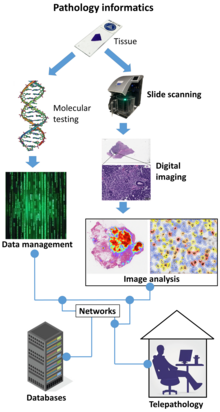
Pathology informatics is a subfield of health informatics. It is the use of information technology in pathology. It encompasses pathology laboratory operations, data analysis, and the interpretation of pathology-related information.
Key aspects of pathology informatics include:
- Laboratory information management systems (LIMS): Implementing and managing computer systems specifically designed for pathology departments. These systems help in tracking and managing patient specimens, results, and other pathology data.
- Digital pathology: Involves the use of digital technology to create, manage, and analyze pathology images. This includes side scanning and automated image analysis.
- Telepathology: Using technology to enable remote pathology consultation and collaboration.
- Quality assurance and reporting: Implementing informatics solutions to ensure the quality and accuracy of pathology processes.
Psychopathology
Psychopathology is the study of
Non-humans
Although the vast majority of lab work and research in pathology concerns the development of disease in humans, pathology is of significance throughout the biological sciences. Two main catch-all fields exist to represent most complex organisms capable of serving as host to a pathogen or other form of disease: veterinary pathology (concerned with all non-human species of
Veterinary pathology
Veterinary pathology covers a vast array of species, but with a significantly smaller number of practitioners, so understanding of disease in non-human animals, especially as regards
Plant pathology
Although the pathogens and their mechanics differ greatly from those of animals, plants are subject to a wide variety of diseases, including those caused by
See also
- Biopsy
- Causal inference
- Cell (biology)
- Disease
- Environmental pathology
- Epidemiology
- Etiology (medicine)
- Hematology
- Histology
- Immunology
- List of pathologists
- Medical diagnosis
- Medical jurisprudence
- Medicine
- Microbiology
- Microscopy
- Minimally-invasive procedures
- Oncology
- Parasitology
- Pathogen
- Pathogenesis
- Pathophysiology
- Precision medicine
- Spectroscopy
- Speech–language pathology
- Telepathology
References
- OCLC 1043350646.)
{{cite book}}: CS1 maint: multiple names: authors list (link) CS1 maint: numeric names: authors list (link - ^ "-pathy, comb. form". OED Online. Oxford English Dictionary (3rd ed.). Oxford University Press. 2005. Retrieved 23 March 2020.
- ISBN 978-1-4160-3121-5.
- ^ a b "Pathology Specialty Description". American Medical Association. Retrieved 5 October 2020.
- ISBN 978-0-486-61342-0.
- ^ Arcolani, Giovanni (1542). "Commentary on the Ninth Book of Medicine Dedicated to Mansur — Commentaria in nonum librum Rasis ad regem Almansorem". World Digital Library (in Latin). Archived from the original on 2014-02-14. Retrieved 2014-03-02.
- ISBN 978-0-8018-4057-9.
- PMID 15492984.
- S2CID 23045808.
- PMID 35481571.
- ISBN 978-1-4160-2973-1.)
{{cite book}}: CS1 maint: multiple names: authors list (link - ^ "Dermatopathology". American Board of Dermatology. Archived from the original on 2010-12-07.
- ^ "Special stains and tests – DermNet New Zealand". 2008. Archived from the original on 2011-05-20.
- ^ "Dermatopathology".
- PMID 17664437.
- ISBN 978-0-89189-581-7.
- .
- ^ Zérah, Simone; McMurray, Janet; Horváth, Andrea Rita (May 2011). "Our profession now has a European name: Specialist in Laboratory Medicine" (PDF). EFCC Newsletter. Paris: European Federation of Clinical Chemistry and Laboratory Medicine. p. 5. Archived (PDF) from the original on 2020-03-23. Retrieved 23 March 2020.
- ^ a b "Bulletin officiel du n°32 du 4 septembre 2003 – MENS0301444A" (in French). Ministère de l'Éducation nationale, de l'Enseignement supérieur et de la Recherche. 4 September 2003. Archived from the original on 2008-03-02.
- PMID 20351699.
- PMID 21036793.
- S2CID 29219804.
- S2CID 206510903.
- PMID 16278751.
- ISBN 978-0721690032.
- ^ Homepage Archived 2007-06-30 at the Wayback Machine of the American Board of Pathology
- ^ Reglementation for French Residency in Clinical Pathology (Biologie médicale) Archived 2008-02-28 at the Wayback Machine
- ^ "Types of Oncologists". Cancer.Net : American Society of Clinical Oncology (ASCO). 2011-05-09. Archived from the original on 1 June 2013. Retrieved 25 May 2013.
- ^ Allen Frances (17 May 2013). "The New Crisis in Confidence in Psychiatric Diagnosis". Annals of Internal Medicine. Archived from the original on 7 June 2013.
- ^ Dalal PK, Sivakumar T. (2009) Moving towards ICD-11 and DSM-5: Concept and evolution of psychiatric classification. Archived 2018-06-02 at the Wayback Machine Indian Journal of Psychiatry, Volume 51, Issue 4, Page 310-319.
- S2CID 16151623.
- ^ "American College of Veterinary Pathologists | for the Public". Archived from the original on October 24, 2013. Retrieved October 3, 2013.
- S2CID 18620094. Archived from the original(PDF) on 2020-10-08. Retrieved 2019-12-17.
External links
 Media related to Pathology at Wikimedia Commons
Media related to Pathology at Wikimedia Commons- American Society for Clinical Pathology (ASCP)
- American Society for Investigative Pathology (ASIP)
- Pathpedia online pathology resource: Comprehensive pathology website with numerous resources.
- College of American Pathologists
- humpath.com (Atlas in Human Pathology)
- Intersociety Council for Pathology Training (ICPI)
- Pathological Society of Great Britain and Ireland
- Royal College of Pathologists (UK)
- Royal College of Pathologists of Australasia (Australia & Oceania)
- United States and Canadian Academy of Pathology
- WebPath: The Internet Pathology Laboratory for Medical Education
- Atlases: High Resolution Pathology Images

